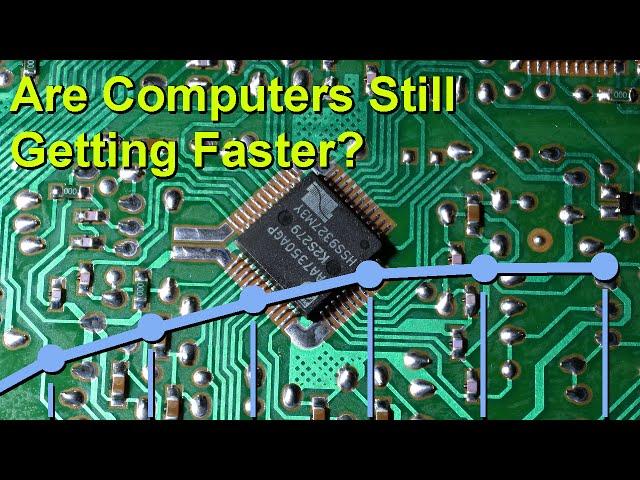Комментарии:

I think the reason for this type of thinking is that this video was made during peak Intel complacency just a few years before AMD and eventually Apple started putting out CPUs that really compete with Intel.
Ответить
8 years ago "Nearly have 200k subscribers"
1.43M subs as of this writing, congrats 8-Bit Guy! :)

it's 2024 and those gigahertz have gone up a lot
Ответить
"Most computers have anywhere between 2 and 4 cores, and some have as many as 8", watching in a time when most computers have 8-16 cores, and some have as many as 64.
Ответить
Its funny you mention the upgradeing the Macbook, because Im watching this while waiting for Windows 7 (my fav) to install on a 2010 Macbook Pro that I found on Craigslist for $20. And I also have a late 2009 and early 2008 macbook just like the one you show, the 2009 one I have Windows on as well. It evens works with an Xbox One controller wirelessly.
Ответить
It must've been alot more fun to be a computer cabinet designer in the 80s than the 90s, I mean you could even work in wood!
Ответить
My thought: single-core performance has more or less peaked and modern CPUs try to find new and interesting ways to improve multi-core performance, but writing threaded software is still extremely difficult so most software is still written to only take advantage of a few or even just one core. Since clock speeds have pretty much leveled off this software will still run just fine on older machines and what you're giving up instead is your ability to multitask as effectively.
Ответить
Watching this video in 2023.
Going back in time with Vista and Windows 8, netbooks and the beginning of the tablets.

Yes they are
Ответить
get ready for 2015 and 2025 comparison lol, its gonna be interesting
Ответить
Thankfully AMD forced Intel back into shape with Ryzen, and now CPUs from even 2016 sometimes cant keep up with today's technology
Ответить
you can still single task most programs with 1GB of memory. The extra memory just isn't needed by get gobbled up by multitasking, which you can kind of give up on and still feel the computer is "usable". Also single core performance barely doubled.
in 1990's there was the operating system revolution into multitasking and realtime multimedia, the applications were really pushing the CPU whereas today there's no killer app that pushes the CPU

Congrats on 100k 😉🤣👍
Ответить
It’s not so much that computers have slowed down in progress; it’s more that user needs/demands have largely halted since the mid-2000’s.
Ответить
Some newer hardware seems to not even handle 3 year old software, like Chromebooks
Ответить
8-Bit Keys is abandoned
Ответить
It's an interesting question, and I agree with each of these theories and love how they all connect with each other!
Ответить
Fun to look back after ~7 years to see this perspective. Would be a great candidate for a follow-up episode, maybe on this video's 10th anniversary. It's almost coming up soonish.
Ответить
Yes.
Ответить
Tbh this video feels outdated now and we need a new one with same topic :)
Ответить
its about lazy, bad, and outright malicious software design failing to keep up with its bloat and inefficiency with the improvements in hardware, as well as the good software designers who try and keep things working better - on top of a grand effort towards unified feature sets and design under the hood.
OSes being designed to brick or heavily slow older systems is an old meme at this point - and that's because it's now so hard for them to actually do that. The reason a core2 processor can still competently run windows 10 isn't just a testament to the quality of the silicon, but to the quality of ALL silicon. The powers that be can't dream up new bloatware fast enough to entirely kill off older processors on the same platform, and can barely even slow them down much.

The last 10 years all advancement in power has mostly been used to lower the energy use, not increase the performance.
Also we move from heavy creator-use to consumer-use. Who builts a website today or edits photos?
And software has flatten out. Word 2019 can basically be instantaneously be replaced by Word 1997 and we continue typing as nothing happened.
Last reason: Pythonify everything. If you recode stuff from C++ to Python, you waste 90% of CPU power. Python swallowed a big chunk of new processing power.

We're at epyc genoa 96 cores 50% more cores than old threadripper 64 cores. I think this theory is true too hardware improves faster than software
Ответить
Notice how are passed 6 years from this video end already evrything Is canged again
Ответить
The really funny thing is that the computing power of like any random system today is definitely good enough to run any software besides the obviously too demanding kinds, but what do you know suddenly they're putting much less Ram in your system like the price like quadrupled or something. You have to buy the top tier system to get enough RAM to do as many things at the same time as you would have expected an older system to do. It's extremely stingy I can't believe how badly they're gouging you to get a normal amount of RAM
Ответить
I think it would be a more fair comparison if we compared server technology, instead of personal computers.
Alot of the stuff we do is on the web off in some Amazon server.
All the processing happens remotely.
Even with CAD programs like Fusion360, a lot is offloaded to the cloud.

I think for the vast majority of software, its mostly gonna be ram intensive, because of all the soydev bullshit going around lmfao.
If anything, its gonna be the GPU that experiences the most growth, not the CPU. Almost exclusively cus of how entertainment has changed.
Using a 2010 GPU in 2022 would be borderline unuseable.
Using a 2015 GPU in 2022 would barely work.
Moores law works just fine, but mostly for GPU's.
Also a lot of software was developed to run entirely on a single thread. It wont really take advantage of multiple cores, so there hasn't been as big of a push to do it anyways.

It's fascinating to look back nearly 7 years and see the conclusions holding true with a minor shift of the scale.
Ответить
Today we use Intel pentium as bios
Ответить
Late commenting, but I look at it like how we grow, taller, then wider, then taller, then wider... All this time, computers have gotten faster on the taller side, going to multiple GHZ, now it's growing on the wide side, filling up all the lanes of traffic..
Ответить
I think the core of it all is about when irl graphics and computer graphics seems to be similar you have reach the end. I allways thought too good graphics makes you lacy. Your fantasy is the best graphics. What I mean is our mind and eyes cant register more than you see in real life.
Ответить
man i dont know jack shit about computers especially old computers but i think i like observing how close knit this community is.
Ответить
Software still running on old hardware also has to do with how we make and package software today and not only how we distribute. We have got standardised specifications for high level languages that just produces fast enough code, more than required already. 2nd the world has finally converged into a few major platforms like Windows, Linux and other POSIX platforms. Even macOS and iOS are also POSIX compatible because of their Unix ancestry. Hardware although still can vary a lot software is generally abstracted from those details. Consider the standard ISAs too, x86-64 CPUs are still fully backward compatible with good old 16bit real modes. Variations of devices have come for sure, but the OS and development platforms are consistent over them, even web browsers play their part in it.
Ответить
But maybe thare secretly geting slower
Ответить
When I upgraded from a Windows 7 computer to a Windows 10, it changed from 10 minutes to 1 second to launch Civilization V.
Ответить
I was using a pc built in 1999 in 2014. I were running program writen for pc in around 2009, and still had my work done right. I was using Sibelius 6 musical scoring program, and I had uodate computer only when I had to write a really big full score because it was running a little slow. My point is, there is not a problem to make job done with old instruments. It's more about marketing and good-looking of software.
Ответить
There's a similar trend with many other things.
For example, a 1958 automobile by today's standards is extremely archaic, but by 1968, some automobiles had power steering, power brakes, power windows and locks, A/C, power seats (with 2 memory settings), and an engine that some cars today only dream of having the same power.
Music is another: The 1940's came and went by the 1950's, but some of us still listen and adore 1960's music.
I'd also say that where modern computers started was a Pentium II with Windows 98 SE, IMHO.

I think the softwares are made more sloppy!
Ответить
I would assume it’s just because while computers have gotten more powerful, the tasks we have to do on them haven’t changed much (really referring to the last 10-20 years). Basically what David said.
Ответить
I think it is worth noting that processing speeds don't seem to be going anywhere particularly fast, not without being insanely expensive, meanwhile RAM seems to be incredibly cheap.
Ответить
I'm aware I'm 6 years late to the discussion, but it still applies today that computer software has finally started slowing down the process of innovation. I know that just because of bloat it would be hard to justifiably run Windows 10 on a Celeron D system nowadays, but when it comes down to more optimized software, like GNU/Linux or a BSD system(love you guys to death), it really doesn't take much more than a healthy amount of RAM, say 4 GB and a 2 GHz processor, hell we can say dual core for good measure, and your granny could be surfing the web as if the hardware inside was brand new. Take away web browsing, and you could easily get away with 2 GB RAM or less!
Ответить
The softwqre does not need so much power. Only games and very math intensive apps need more today. Everything else can work fkne with a 10 year old processor and ram.
Ответить
The reason is bill gates and other shits like him
Ответить
YOU HAVE 64 CORE CPU'S NOW.
Ответить
I'd be really interested to see this topic revisited now in 2022 to see if things have slowed down a lot more in the last five years.
I recently had to buy a new machine (a PC) for graphics, and I was surprised to find that the specs were almost identical to a similar computer (a mac) that I bought in 2015, also for graphics. While shopping, I also noticed that new consumer-grade computers are still using more-or-less the same amount of RAM and CPU as an old iMac I've had since 2013, which was nothing special at the time

In 2022, I'm still using my 2012 Mac Pro as my daily driver. It's rock solid with 8 cores 16 threads at 3.33GHz and 48GB of RAM. I threw in an SSD and a GTX-1060 6GB. Runs as smooth as butter with Windows 10. Now I know it was an expensive computer back in the day, but I see no reason to upgrade at all. Kinda odd that a 10 year old Mac is still super powerful today! I would never run a 2002 G4 Mac in 2012.
Ответить
Software is to blame. Computer may be able to run, but companies like Microsoft, Apple or Samsung wants You to buy new ones, so older are removed from update path.
Ответить
You might also want to include the speed increase in hard disk read/write times, and of RAM.
Ответить

![저 세상 하이파이브 치는 레전드 영상 모음 - [파쿠르] 저 세상 하이파이브 치는 레전드 영상 모음 - [파쿠르]](https://invideo.cc/img/upload/b1RIRHhMeVhiMms.jpg)

![구급대원 : 3분안에 도착합니다!!! - 출동 1인칭 [파쿠르] 구급대원 : 3분안에 도착합니다!!! - 출동 1인칭 [파쿠르]](https://invideo.cc/img/upload/UUJ2Z3haeURmTXU.jpg)






















